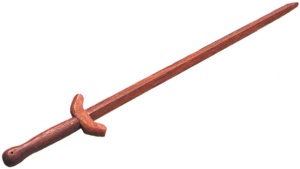Difference between revisions of "Waster"
| Line 1: | Line 1: | ||
| + | {{InterwikiLink:Waster}} | ||
| + | {{ST|stack={{Infobox:Manufacture | ||
| + | | image = Waster.jpg | ||
| + | | comment = Image Source: [http://sinai.critter.net Sinai] | ||
| + | | type = Weapons | ||
| + | | skill = Manufacturing weapons | ||
| + | | time = 2 | ||
| + | | resources = 160 grams of [[wood]] | ||
| + | | objects = | ||
| + | | tools = {{knife}} | ||
| + | | machines = | ||
| + | | location = | ||
| + | | rot = 49 | ||
| + | | userot = | ||
| + | | repair = 1100 | ||
| + | }} | ||
| + | {{Infobox:Holdable | ||
| + | | attack = 01 | ||
| + | | skillweight = 80 | ||
| + | | defense = | ||
| + | | weight = 160 | ||
| + | | visible = yes | ||
| + | }}}} | ||
| + | ==Description and uses== | ||
| + | An excellent training [[:Category:Weapons|weapon]], and an alternate to the [[feather pillow]], as they do very little damage or none at all, in both [[Skills#hunting|hunting]] and [[Skills#fighting|fighting]], while still allowing your [[Skills#Physical_strength|physical strength]] to increase. | ||
| + | |||
| + | ==Real-life context== | ||
| + | Since Roman times, through the Middle Ages and Renaissance, wooden weapons were used throughout Europe for training and practice by warriors, men-at-arms, knights and students of fencing. Wasters save wear and tear on valuable steel swords and help build strength and coordination. Also called "bavins" or later on "cudgels", wooden swords were often of double weight for instructing squires or for use on pells or even tournaments. - [http://www.woodenswords.com/faq.htm] | ||
Revision as of 03:32, 17 September 2013
| Interwiki |
|---|
|
български • Deutsch • English • Español • Esperanto • Français • Italiano • Lietuvių • Lojban • Nederlands • Polska • Português • Русский • Suomi • Svenska • Türkçe • 中文 |
| |||||||||||||||||||||||||||||||||
Description and uses
An excellent training weapon, and an alternate to the feather pillow, as they do very little damage or none at all, in both hunting and fighting, while still allowing your physical strength to increase.
Real-life context
Since Roman times, through the Middle Ages and Renaissance, wooden weapons were used throughout Europe for training and practice by warriors, men-at-arms, knights and students of fencing. Wasters save wear and tear on valuable steel swords and help build strength and coordination. Also called "bavins" or later on "cudgels", wooden swords were often of double weight for instructing squires or for use on pells or even tournaments. - [1]
